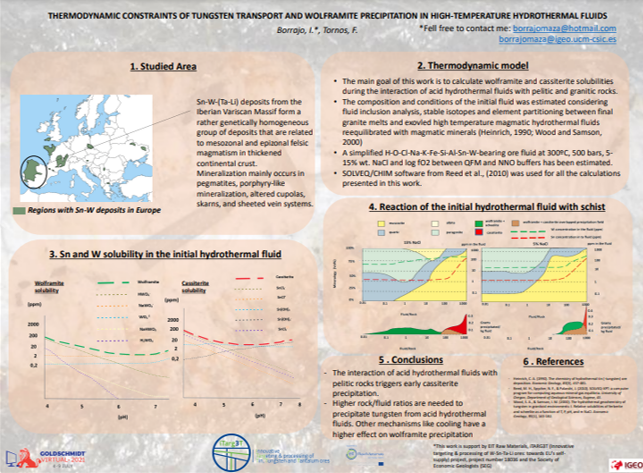
Granite-related tungsten-(tin) mineralization in Iberia occurs as endo- to peri-granitic porphyry-like, breccia pipes, quartz-vein, greisen, and calcic and magnesian skarns. More than the 80% of wolframite mineralization in Iberia is hosted by endo- to exo-granitic well-defined large quartz-muscovite veins and their greisenized selvages. Less common, but also economic, mineralization is associated with A-type quartz-feldspar veins, pegmatites and miarolitic cavities within zones of pervasive feldspar (potassic and sodic) metasomatic alteration in the apex of felsic intrusives (e.g., Las Sombras and Carris) or even as likely magmatic disseminations in evolved granitic cupolas (e.g., Fontao and Santa Comba). This early magmatic to early magmatic-hydrothermal mineralization is thought to be equivalent to that forming porphyry systems.
Related granitoids show extensive metasomatic hydrothermal alteration which commonly starts at high temperature during the magmatic-hydrothermal transition in the form of a feldspar-biotite potassic alteration followed by a later and pervasive, more acid and lower temperature hydrothermal alteration dominated by the quartz-muscovite assemblage.
Fluid inclusion, thermodynamic constraints and isotopic data show that this mineralization is formed at temperatures between ca. 250°C and 400 °C, fluid pressures between 200 and 1500 bar, and related with fluids with a pH at or slightly below the QFMASH equilibria and fO2-fS2 close to the PPM and NNO buffers. These fluids are systematically of low to intermediate density (<15 wt % NaCl eq., and abundant CO2-CH4). Within this work we present a novel thermodynamic model for tungsten transport in high temperature (up to 500°C) aqueous hydrothermal fluids and we evaluate the different mechanisms which potentially trigger the wolframite precipitation. Numerical calculations using CHNSOZ and SOLVEQ-XPT programs show that tungsten was dominantly transported as H2WO4 and HWO4- aqueous complexes and wolframite precipitation is driven by different mechanisms, dominantly boiling, fluid mixing and fluid-rock reaction.
This research has been conducted within the iTarg3T and has received funding by the European Union Horizon 2020 research.
Goldschmidt Virtual 2021. 4-9 July
One of the wealthiest tungsten-tin-(tantalum-lithium) mineral belts worldwide is located in western and central-eastern Europe, where different types of mineralization are related to highly evolved peraluminous granitic rocks. These ore deposits were intensely mined till the 1980’s when the global crash of
metal prices triggered the closure of most of the tin mines. More recently, market and political changes initiated the gradual reactivation of this mining sector and currently, there are several producing mines and tens of advanced exploration projects. However, most of these projects are brownfields and occur in or near already existing mine sites. This is partially caused by several issues that are specific for this type of mineralization. The deposits are usually low tonnage and mostly worked by SME’s, they form irregular masses or narrow veins with difficult grade control, resource evaluation, and ore processing. Furthermore, the restricted geographic location, away from the major ore belts, and the price crisis have kept these deposits away from the recent advances of conceptual exploration. All of these problems have hampered greenfields exploration and advances in ore concentration and resource estimation.
The iTARG3T project aims to contribute significantly to the discovery and development of new sources of tin, tungsten, tantalum and lithium in Europe by improving exploration in technically challenging environments and developing mineral processing solutions.
VII International Conference. Young Researchers´Innovative Ideas: Science, Start-up, Industry. 27th and 28th May 2021
We have assessed the feasibility of delineating and identifying mineral ores from images of mine excavation faces, taking samples from a gallery mine in Sn - W pegmatitic vein deposits for a case of study. This study consisted on:
1. Analysis of laboratory hyper-spectral images (450 - 1780 nm) of the different minerals of interest from samples collected in the mine to evaluate spectral separability and machine-learning classification under close-to-optimal conditions.
2. Analysis and spectral classification of a hyper-spectral image (950 - 1780 nm) of a panel of samples in the vertical position, acquired under room conditions from a distance of 2.5 m, as a previous test of (i) the deployment of the hyper-spectral equipment in the mine and (ii) the analysis of images acquired in sub-optimal conditions, closer to those expected to be present in gallery mines.
3. Automatic segmentation of conventional digital photos of the mine excavation front to delineate patches of mineral ores and estimate ore grade.
The analysis of laboratory hyper-spectral images indicated that all spectral signatures are statistically separable although care has to be taken with quartz forms including numerous impurities. Classification (Linear Discriminant Analysis, Singular Vector Machines and Random Forest) of laboratory spectra had a very high accuracy rate (up to 98%). In the case of the panel, classification accuracy was highest using Random Forests (93.2%). Segmentation of a conventional image of the mine excavation face successfully delimited ore patches and provided area measurements, thus facilitating area-based ore grade estimates. Our results show the interest and feasibility of the combined use of conventional and hyper-spectral imagery to assess and map mineral ores in mine excavation faces objectively.
See the comunication here
Lobo, A., García, E., Barroso, G., Martí, D., Fernandez-Turiel, J.L.,
Ibáñez Insa, J., 2021. Machine-Learning classification of proximal
conventional and hyper-spectral imagery. Presented at the Second
Workshop : Hyperspectral Sensing meets Machine Learning and Pattern
Analysis [HyperMLPA].
Copyright © 2021 iTarg3T